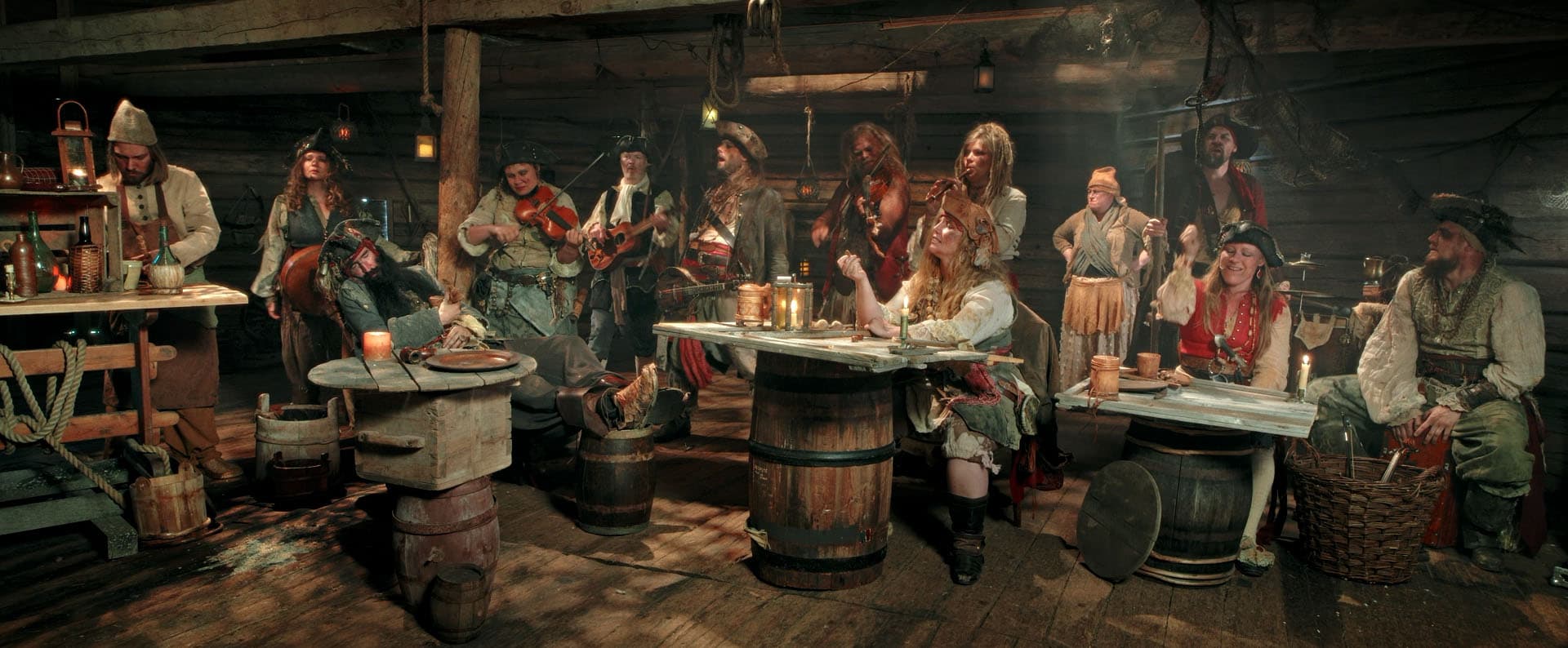Raise Your Glass
Partnering with the rowdy pirate folk band Ye Banished Privateers (YBP), and the amazing cinematographer Kenneth Ly we developed and produced "Raise Your Glass" a full-motion interactive music video experience. Set to their rousing sea shanty-style music, the browser-based adventure starts with a pirate waking up after a wild night, tasked with finding three coins to settle their tavern debt before the song ends and their crew sails without them.
Try it Yourself:Experience the interactive adventure hereThe Experience
The adventure begins as the user groggily awakens in a tavern loft. Through point-and-click interactions within the live-action video, players explore the environment and the band members. Each click trigger different video segments, revealing new paths or items. The goal is a race against the clock – the duration of the YBP track "Raise Your Glass" – to find three coins and secure freedom. Failure means being left behind as the ship departs.





Development & Production
The project kicked off with collaborative concept development alongside YBP, mapping out the branching narrative possibilities in a detailed flowchart.

To visualize scene blocking and camera angles early on, I created preliminary 3D mockups using Unreal Engine. These were also used for early testing the concept of seamless video switching in the browser.



The core full-motion video was shot over four days, plus an additional day dedicated to the opening scene, utilizing various locations around Umeå, Sweden. We employed creative practical effects to enhance the visuals, such as rigging internal lighting to simulate sunlight pouring through a newly opened boarded-up window – a simple trick with a fantastic result.






Technical Implementation & Challenges
A key requirement from YBP was high accessibility: the experience needed to run smoothly in a web browser without requiring any downloads. This led to exploring various web video technologies.
Core functionality and challenges
The core technical solution involves dynamically stacking HTML5 video elements, preloading potential next video clips based on user interaction points, and unloading clips that are no longer reachable in the narrative tree.
Initial tests with streaming platforms like Cloudflare Stream and MUX revealed potential cost issues due to their quota-based pricing. Given the video's length (over four minutes) and the aggressive preloading strategy needed for seamless transitions, these quotas could be rapidly consumed, leading to great costs at scale.
Inspired by research (including helpful insights from screencasting.com's blog on affordable video hosting), I implemented a more cost-effective and robust solution. This ment transcoding the source video files into HLS (HTTP Live Streaming) format using FFMPEG and hosting these segmented video streams on Cloudflare R2 storage. The critical advantage of R2 is its lack of egress fees, making it exceptionally well-suited for this high-volume streaming scenario while providing valuable hands-on experience with HLS transcoding. I modified screencasting.com's transcoding script to fit our needs and allow for batch processing. For uploading and managing the files in the R2 storage I used rclone which gave me all the flexibility I needed for this.
Frontend
The frontend was built using Next.js, managing the video component loading, swapping, and unloading logic. For interactivity, PixiJS was layered over the video elements, providing an efficient way to manage hitboxes, graphical overlays, and the custom point-and-click style cursor, enhancing the old-school adventure game aesthetic.
An experimental feature involving rendering the video to a canvas and applying real-time shader effects (distortions, color grading) was prototyped. While promising on high-end machines, performance bottlenecks on lower-spec devices and mobiles led to its exclusion from the final release due to budget and time constraints. Optimizing the render pipeline (potentially avoiding the video-element-to-canvas round trip) remains an interesting area for future exploration.
Since the music is running as it's own audio file the videos are being synced to it when they are preloaded. If the video drifts for some reason it can be slightly slowed down or sped up to get back into sync.
Data & Future Potential
Each playthrough is anonymously tracked by logging interaction choices (hitbox clicks) and timestamps to Supabase. This data allows for easy session recreation and analysis. While not implemented within the initial budget, this tracking opens possibilities for future add-ons, such as generating a personalized, non-interactive video cut of the user's specific path or creating a text-based summary ("You first went to the bar, then took the broom...") based on their unique journey.